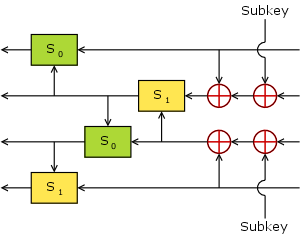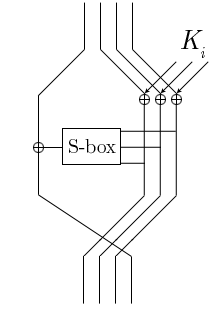Related Research Articles

The Data Encryption Standard is a symmetric-key algorithm for the encryption of digital data. Although its short key length of 56 bits makes it too insecure for modern applications, it has been highly influential in the advancement of cryptography.
Differential cryptanalysis is a general form of cryptanalysis applicable primarily to block ciphers, but also to stream ciphers and cryptographic hash functions. In the broadest sense, it is the study of how differences in information input can affect the resultant difference at the output. In the case of a block cipher, it refers to a set of techniques for tracing differences through the network of transformation, discovering where the cipher exhibits non-random behavior, and exploiting such properties to recover the secret key.
Articles related to cryptography include:
In cryptography, Lucifer was the name given to several of the earliest civilian block ciphers, developed by Horst Feistel and his colleagues at IBM. Lucifer was a direct precursor to the Data Encryption Standard. One version, alternatively named DTD-1, saw commercial use in the 1970s for electronic banking.
Snefru is a cryptographic hash function invented by Ralph Merkle in 1990 while working at Xerox PARC. The function supports 128-bit and 256-bit output. It was named after the Egyptian Pharaoh Sneferu, continuing the tradition of the Khufu and Khafre block ciphers.

The GOST block cipher (Magma), defined in the standard GOST 28147-89, is a Soviet and Russian government standard symmetric key block cipher with a block size of 64 bits. The original standard, published in 1989, did not give the cipher any name, but the most recent revision of the standard, GOST R 34.12-2015, specifies that it may be referred to as Magma. The GOST hash function is based on this cipher. The new standard also specifies a new 128-bit block cipher called Kuznyechik.

In cryptography, FEAL is a block cipher proposed as an alternative to the Data Encryption Standard (DES), and designed to be much faster in software. The Feistel based algorithm was first published in 1987 by Akihiro Shimizu and Shoji Miyaguchi from NTT. The cipher is susceptible to various forms of cryptanalysis, and has acted as a catalyst in the discovery of differential and linear cryptanalysis.
In cryptography, LOKI89 and LOKI91 are symmetric-key block ciphers designed as possible replacements for the Data Encryption Standard (DES). The ciphers were developed based on a body of work analysing DES, and are very similar to DES in structure. The LOKI algorithms were named for Loki, the god of mischief in Norse mythology.

In cryptography, MacGuffin is a block cipher created in 1994 by Bruce Schneier and Matt Blaze at a Fast Software Encryption workshop. It was intended as a catalyst for analysis of a new cipher structure, known as Generalized Unbalanced Feistel Networks (GUFNs). The cryptanalysis proceeded very quickly, so quickly that the cipher was broken at the same workshop by Vincent Rijmen and Bart Preneel.
In cryptography, REDOC II and REDOC III are block ciphers designed by cryptographer Michael Wood for Cryptech Inc and are optimised for use in software. Both REDOC ciphers are patented.
The slide attack is a form of cryptanalysis designed to deal with the prevailing idea that even weak ciphers can become very strong by increasing the number of rounds, which can ward off a differential attack. The slide attack works in such a way as to make the number of rounds in a cipher irrelevant. Rather than looking at the data-randomizing aspects of the block cipher, the slide attack works by analyzing the key schedule and exploiting weaknesses in it to break the cipher. The most common one is the keys repeating in a cyclic manner.

In cryptography, the boomerang attack is a method for the cryptanalysis of block ciphers based on differential cryptanalysis. The attack was published in 1999 by David Wagner, who used it to break the COCONUT98 cipher.
Introduced by Martin Hellman and Susan K. Langford in 1994, the differential-linear attack is a mix of both linear cryptanalysis and differential cryptanalysis.
In cryptography, impossible differential cryptanalysis is a form of differential cryptanalysis for block ciphers. While ordinary differential cryptanalysis tracks differences that propagate through the cipher with greater than expected probability, impossible differential cryptanalysis exploits differences that are impossible at some intermediate state of the cipher algorithm.
In cryptography, integral cryptanalysis is a cryptanalytic attack that is particularly applicable to block ciphers based on substitution–permutation networks. It was originally designed by Lars Knudsen as a dedicated attack against Square, so it is commonly known as the Square attack. It was also extended to a few other ciphers related to Square: CRYPTON, Rijndael, and SHARK. Stefan Lucks generalized the attack to what he called a saturation attack and used it to attack Twofish, which is not at all similar to Square, having a radically different Feistel network structure. Forms of integral cryptanalysis have since been applied to a variety of ciphers, including Hierocrypt, IDEA, Camellia, Skipjack, MISTY1, MISTY2, SAFER++, KHAZAD, and FOX.
In cryptography, KN-Cipher is a block cipher created by Kaisa Nyberg and Lars Knudsen in 1995. One of the first ciphers designed to be provably secure against ordinary differential cryptanalysis, KN-Cipher was later broken using higher order differential cryptanalysis.
In cryptography, Ladder-DES is a block cipher designed in 1994 by Terry Ritter. It is a 4-round Feistel cipher with a block size of 128 bits, using DES as the round function. It has no actual key schedule, so the total key size is 4×56=224 bits.
In cryptography, COCONUT98 is a block cipher designed by Serge Vaudenay in 1998. It was one of the first concrete applications of Vaudenay's decorrelation theory, designed to be provably secure against differential cryptanalysis, linear cryptanalysis, and even certain types of undiscovered cryptanalytic attacks.
In cryptography, the Davies attack is a dedicated statistical cryptanalysis method for attacking the Data Encryption Standard (DES). The attack was originally created in 1987 by Donald Davies. In 1994, Eli Biham and Alex Biryukov made significant improvements to the technique. It is a known-plaintext attack based on the non-uniform distribution of the outputs of pairs of adjacent S-boxes. It works by collecting many known plaintext/ciphertext pairs and calculating the empirical distribution of certain characteristics. Bits of the key can be deduced given sufficiently many known plaintexts, leaving the remaining bits to be found through brute force. There are tradeoffs between the number of required plaintexts, the number of key bits found, and the probability of success; the attack can find 24 bits of the key with 252 known plaintexts and 53% success rate.
The following outline is provided as an overview of and topical guide to cryptography:
References
- ↑ John Gilmore (July 13, 1989). "Merkle's "A Software Encryption Function" now published and available". Newsgroup: sci.crypt. Usenet: 7981@hoptoad.uucp.
- ↑ Frank Cunningham (August 14, 1989). "the recent uproar". Newsgroup: sci.crypt. Usenet: 497@lexicon.com.
- ↑ "Merkle's "A Software Encryption Function" now published and available". groups.google.com.
- ↑ U.S. patent 5,003,597
- General
This article includes a list of general references, but it lacks sufficient corresponding inline citations .(March 2009) |
- R.C. Merkle (August 1990). Fast Software Encryption Functions (PDF/PostScript). Advances in Cryptology— CRYPTO '90. Santa Barbara, California: Springer-Verlag. pp. 476–501. Retrieved August 23, 2007.
- Eli Biham; Adi Shamir (August 1991). Differential Cryptanalysis of Snefru, Khafre, REDOC-II, LOKI and Lucifer (PDF/PostScript). Advances in Cryptology—CRYPTO '91. Santa Barbara, California: Springer-Verlag. pp. 156–171. Retrieved August 23, 2007.
- Henri Gilbert; Pascal Chauvaud (August 1994). A Chosen Plaintext Attack of the 16-round Khufu Cryptosystem. Advances in Cryptology—CRYPTO '94. Santa Barbara, California: Springer-Verlag. pp. 359–368.
- Bruce Schneier; John Kelsey (February 1996). Unbalanced Feistel Networks and Block Cipher Design (PDF/PostScript). 3rd International Workshop on Fast Software Encryption (FSE '96). Cambridge: Springer-Verlag. pp. 121–144. Retrieved August 23, 2007.
- Eli Biham; Alex Biryukov; Adi Shamir (March 1999). Miss in the Middle Attacks on IDEA, Khufu and Khafre. 6th International Workshop on Fast Software Encryption (FSE '99). Rome: Springer-Verlag. pp. 124–138. Archived from the original (gzipped PostScript) on May 15, 2011. Retrieved February 14, 2007.
- David Wagner (March 1999). The Boomerang Attack (PDF/PostScript). 6th International Workshop on Fast Software Encryption (FSE '99). Rome: Springer-Verlag. pp. 156–170. Retrieved February 5, 2007.